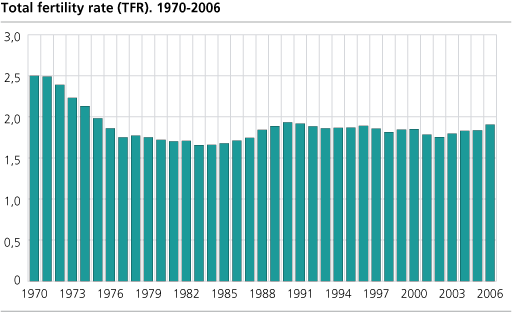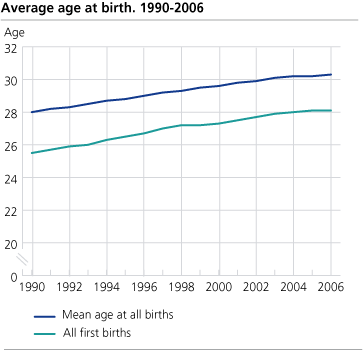Content
Published:
This is an archived release.
Highest fertility since 1991
In 2006, 58 500 children where born in Norway, and the total fertility rate (TFR) was 1.90, the highest rate since 1991.
TFR in 1990 and 1991 was 1.93 and 1.92 respectively, and before then, we must look to the beginning of the 1970s to find a higher value. In the 1974-1989 period, the TFR varied between 2.13 and 1.66. In the 1992-2005 period, the TFR was more stable and had values between 1.75 and 1.89.
The total fertility rate (TFR) describes the average number of babies born alive per woman in the course of her life, under the provision that the fertility pattern in the period applies to the woman's entire reproductive period (15-49 years) and that deaths do not occur. |
Highest fertility in Rogaland
Rogaland had the highest fertility rate with 2.14 children per woman. Rogaland is therefore the only county where the fertility rate is high enough to ensure the reproduction of the population. This means that enough children are born to ensure the population will not decrease on the long run migrations not taken in to consideration. Next to Rogaland, the counties Nord-Trøndelag and Vest-Agder follow with a TFR of 2.07 and 2.04. The counties Telemark, Oppland and Hedmark have the lowest rate with 1.73, 1.79 and 1.80 children per woman.
Compared with 2005, all counties experience a rise in TFR, apart from Sogn og Fjordane, Møre og Romsdal and Nordland. Sogn og Fjordane and Møre og Romsdal, however, have relatively high TFR values compared to the country as a whole.
Average age of mothers 28.1 years
The average age of those who gave birth for the first time, was 28.1 years in 2006, the same as in 2005. Women aged 25-29 had the highest fertility. Compared to 2005, women in all ages had an increased fertility, and women aged 30-34 had the highest increase. The fertility in this group has increased steadily since 2001, for other age groups it has varied somewhat more.
13 per cent 1 had single mothers
Nearby half of the children born in 2006 - 46 per cent - had married parents. 41 per cent 1 had parents living in cohabitation and 13 per cent1 had a single mother. The proportion of single mothers has gradually increased since 2001, when the proportion was 8 per cent. Of the various parts of the country, Northern Norway has the largest proportion of children born by single mothers, 21 per cent 1 . The proportion of children with married parents is steadily decreasing. Children born in Trøndelag, Hedmark and Oppland, as well as Northern Norway, had the largest proportion of cohabitating parents.
1 The numbers has been corrected, 17.04.2013.
| Live births, by cohabitation status and part of the country. 2006. Per cent |
| Married | Cohabitant | Single | Proportion cohabitants of all mothers in union, marriages and cohabitations | ||||||||||||||||||||||||||||||||||||
|---|---|---|---|---|---|---|---|---|---|---|---|---|---|---|---|---|---|---|---|---|---|---|---|---|---|---|---|---|---|---|---|---|---|---|---|---|---|---|---|
| Per cent | |||||||||||||||||||||||||||||||||||||||
| Part of the country | |||||||||||||||||||||||||||||||||||||||
| Oslo and Akershus | 53 | 37 | 10 | 41 | |||||||||||||||||||||||||||||||||||
| Hedmark and Oppland | 37 | 50 | 14 | 57 | |||||||||||||||||||||||||||||||||||
| South-East Norway | 47 | 44 | 9 | 48 | |||||||||||||||||||||||||||||||||||
| Agder and Rogaland | 56 | 35 | 10 | 38 | |||||||||||||||||||||||||||||||||||
| Western Norway | 43 | 45 | 12 | 51 | |||||||||||||||||||||||||||||||||||
| Trøndelag | 35 | 54 | 11 | 60 | |||||||||||||||||||||||||||||||||||
| Northern Norway | 34 | 49 | 17 | 59 | |||||||||||||||||||||||||||||||||||
Tables:
- Table 1 Live births and late foetal deaths. 1951-2006
- Table 2 Confinements of single and multiple births, by sex. 1991-2006
- Table 3 Age-specific fertility rates and total fertility rate. 1961-2006
- Table 4 Average age at birth. 1946-2006
- Table 5 Total fertility rate, by county. 1968-2006
- Table 6 Live births, by parity. 1978-2006
- Table 7 Live births, by parity, cohabitation status of mother and county. 2006
- Table 8 Number of children distributed, by age and cohort . Per cent
Contact
-
Statistics Norway's Information Centre
E-mail: informasjon@ssb.no
tel.: (+47) 21 09 46 42
-
Espen Andersen
E-mail: espen.andersen@ssb.no
tel.: (+47) 92 61 00 46
-
Ane Margrete Tømmerås
E-mail: ane.tommeras@ssb.no
tel.: (+47) 91 99 29 62
-
Oppdrag befolkningsstatistikk
E-mail: befolkning@ssb.no


